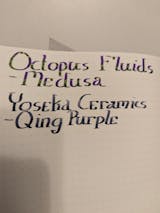













Yoseka Ceramics Ink Series - Qing Purple
- Regular price
- $20.00
- Sale price
- $20.00
- Regular price
-
- Unit price
- / per
Produced in collaboration with Ink Institute and ceramic artist Li Yan Xun, our Yoseka Ceramics Ink Series showcases 8 unique colors inspired by ceramic glazes from the Yuan, Ming, Tang, Qing, and Song Dynasties, spanning 10 centuries of Chinese color and history. We worked closely with Li to select these 8 colors from his Yan Cai color project, in which he used chemical experimentation to revive the formulas of over 60 historical glazes, to represent the brilliant and splendid history of Chinese ceramics.
This rich eggplant purple emerges from the coloring agents cobalt and manganese when fired at a low and consistent temperature. First appearing in the late Yuan and early Ming Dynasties, this aubergine glaze reached its peak of popularity during the Kangxi Emperor’s reign in the Qing Dynasty (1644-1912), when the chemical formula was perfected. The dramatic gloss is a key feature of this glaze, which suggests opulence and auspiciousness.

- Qing Purple (清代紫) – eggplant purple with green sheen
- 30ml
- Dye-based
- A portion of the proceeds from the sale of Yoseka Ceramics Inks will fund the Yanshan Art Museum to support the work of Li Yan Xun
- Available as Ink Sample - Yoseka Ceramics
- More Yoseka Ceramics Inks
- More Yoseka Special Projects
About Li Yanxun: Li Yan Xun is a ceramic artist and the founder of the Yanshan Art Museum in Jingdezhen, China. Hailing from a family of ceramic artists, he received formal training at the renowned Jingdezhen Ceramic Institute before starting his own ceramics studio. In addition to inheriting the “watercolor glaze” techniques pioneered by his father, Li Xiaocong, Li Yan Xun spent almost a decade researching and cataloguing the glaze pigments used in Jingdezhen during the Ming and Qing Dynasties. Experimenting with chemical methods like glaze reduction tests and pure reagent analyses, he revived more than 60 historic glazes and documented each formula. Through this color project, titled Yan Cai, Li pursues the notion that an artist can be involved in every phase of their art-making process, from the development of the medium, to the physical craftsmanship, to the firing and completion of the object.







Used in my Sailor PGS MF nib. The ink is on the dry side and the color is more muted in real life than in the swatch. The sheen is there but I can’t really see it in my MF nib. I will definitely recommend using the ink in a broader nib (probably at least B if you want more sheen). Solid bottle and packaging.
Tested with a Sailor Hocoro 2mm stub, and Fude tip dip pens. Papers used were Tomoe River, Rhodia, Wearingeul, and Iroful. In all instances it appeared as a high shading purple. There was no sheen whatsoever when used in print or cursive. On swatch pad, which is Wearingeul, the ink just appears as a deep purple with decent shading. If you are looking for what is shown in the example photos, you will most likely be dissappointed. If you want to buy a decently shading dusty eggplant color, I would still probably point you in a different direction. Otherwise, it seems to perform just like any other standard ink. Did not dry out super fast on the pen, with average dry time on the paper.
Uploaded image is Qing Purple (bottom) compared to a similarly colored ink, Medusa (Top). Paper is Iroful dot grid. (The only paper I can get sheen on either ink).
This is a deep and pure ink! The purple is incredibly rich - reminiscent of black beauty eggplants in the sun, down to the body and with the green sheen exactly life the plant leaves. This ink flows beautifully; I've been delighted with how it shows up on paper with F, MF, and M nibs.
Awesome color
I always loved the look of purple and green together. The green sheen is so cool when it peeks through! When the pen is freshly inked, the purple shades slightly lighter at the beginning of a word. As it sits in the pen for longer, the overall color grows darker and the sheening is more pronounced. Lovely flow. I find myself reaching for this ink often when it's time to refill my broader pens.


